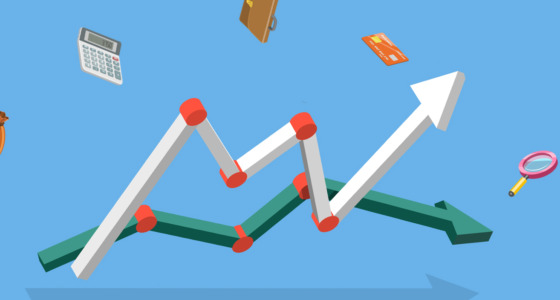

Pivot points (PP) are an effective indicator used by many traders. Although they are calculated automatically, you can measure them by hand. There are four main types of indicators, and other types are being developed. Unlike other indicators, every type of PP was developed by different analysts. Only one name is known: Nicolas Scott developed Camarilla pivot points in the 1980s.
Pivot points in trading
The pivot point indicator predicts support and resistance levels in the current or upcoming session.
The standard indicator consists of five lines:
- A pivot point (PP) stands for the middle line and determines the overall trend.
- Two levels above it (R1 and R2) reflect the resistance levels.
- Two levels below it (S1 and S2) stand for support levels.
These levels are calculated based on the previous trading day’s high, low, and close prices.
Pivot Point (PP) = (Maximum + Minimum + Close)/3
Support 1 (S1) = (PP x 2) – Previous Maximum
Support 2 (S2) = PP – (Previous Maximum – Previous Minimum)
Resistance 1 (R1) = (PP x 2) – Previous Minimum
Resistance 2 (R2) = PP + (Previous Maximum – Previous Minimum)
If the price is above the pivot point, it’s likely to reach the first resistance level. If it’s broken, the next resistance will become a target. Vice versa, two support levels will become targets for upcoming price movements when the price falls below the pivot point.
Pivot points: types
There are four types of pivot point indicators. The standard one was discussed above. The other three types are:
1. Woodie pivot point
It adds more weight to the closing price.
Calculation:
R2 = PP + Maximum – Minimum
R1 = (2 X PP) – Minimum
PP = (Maximum + Minimum + 2Close) / 4
S1 = (2 X PP) – Maximum
S2 = PP – Maximum + Minimum
2. Camarilla pivot point
Camarilla pivot points also put more weight on the closing price, but there are nine levels – a pivot, four resistance, and four support levels.
Calculation:
R4 = Close + ((Maximum – Minimum) x 1.5000)
R3 = Close + ((Maximum – Minimum) x 1.2500)
R2 = Close + ((Maximum – Minimum) x 1.1666)
R1 = Close + (Maximum – Minimum) x 1.0833)
PP = (H + L + C) / 3
S1 = Close – ((Maximum – Minimum) x 1.0833)
S2 = Close – ((Maximum – Minimum) x 1.1666)
S3 = Close – ((Maximum – Minimum) x 1.2500)
S4 = Close – ((Maximum – Minimum) x 1.5000)
3. Fibonacci pivot point
This type uses Fibo levels for the calculation of support and resistance targets.
R3 = PP + ((Maximum – Minimum) x 1.000)
R2 = PP + ((Maximum – Minimum) x 0.618)
R1 = PP + ((Maximum – Minimum) x 0.382)
PP = (H + L + C) / 3
S1 = PP – ((Maximum – Minimum) x 0.382)
S2 = PP – ((Maximum – Minimum) x 0.618)
S3 = PP – ((Maximum – Minimum) x 1.000)
How to use pivot points in trading
Pivots are applied to various assets and timeframes. Pivot points can be daily, weekly, monthly, or yearly. The levels change depending on the period you choose.
For example, if it is Tuesday morning, daily pivots will be calculated using high, low, and close asset prices set on Monday.
When learning how to use pivot points in day trading, you may be confused. However, the names of pivots don’t correlate with the timeframes they are used on. For example, you should apply daily pivots to trade on timeframes up to 30-minutes. You should use weekly pivots to trade on hourly, 4-hour, and daily charts. The weekly levels are changed only once a week and are calculated on the previous week’s high, low, and close prices.
When trading on a weekly timeframe, you should use monthly pivots. They are built on the previous month’s data. If you plan to hold a position for months, you should use yearly pivots. It uses the high, low, and close of the previous year.
Pivot points are mainly used by day traders because daily pivots change every day while weekly, monthly, and yearly levels are updated rarely. Therefore, they can’t be accurate and don’t provide reliable signals.

How to calculate pivot points
When you add a pivot point indicator to your chart, there will be an automatic calculation of the levels. However, you can also calculate levels manually if necessary. Before doing so, you should remember that pivot points are based on the previous trading day’s high, low, and close, and they are mainly used by day traders.
So, if it’s a Tuesday morning, you can use the high, low, and close from Monday, making the pivot point levels for the Tuesday trading day.
1. Look for the high and low of the day either before the market closing or the market opening the following day. Also, check the most recent trading day’s close.
2. Take the high, low, and close, add them up, then divide them by three.
3. Next, use “P” to mark the price on the chart.
4. As you discover the P, calculate the R1, R2, S1, and S2. In the calculations, the high and low will be from the previous trading day.
Here are the calculation formulas so it’s easier to obtain the pivot points:
· Pivot point (PP) = (High + Low + Close) / 3
Then, here’s how to calculate first and second-level resistance:
· First resistance (R1) = (2 x PP) – Low
· Second resistance (R2) = PP + (High – Low)
Lastly, here is how you calculate first and second-level support:
· First support (S1) = (2 x PP) – High
· Second support (S2) = PP – (High – Low)
What do pivot points tell you?
Pivot points are used for commodities, stocks, and futures as intraday indicators. They do not change in price as the day progresses. This allows traders to develop a better trading strategy while taking advantage of the price levels.
Many traders are aware of the fact that they will be buying when the price exceeds the pivot point, and they will be short-selling when it goes below the pivot point.
As part of their trading plan, traders tend to mix pivot points with different other trend indicators. Pivot points can become way stronger resistance or support levels when they overlap with 50-period or 200-period Fibonacci extension or moving average levels.
Day trading with pivot points
Pivot points are commonly used by day traders to calculate levels of stops, profit-taking, and entry. You can perform trend analysis in multiple ways using pivot points. When you’re analyzing trends, they will simply tell what’s going on in a mechanical way.
Pivot points can be applied to shorter amounts of time considering they offer data from one trading day, which makes them more convenient.
They are easy to use, and the good news is that the indicator is available on most trading platforms. Pivot points also provide a lot of data, and they represent one of the most accurate tools in trading.
It’s not hard to use pivot points in day trading. When the opening price of a stock is lower than the Basic Pivot Level, it points toward a bearish bias. But if the opening price is higher than the PP, it indicates a bullish bias. In case R1 is bypassed, you can set your target at R2 and purchase the stock.
Pivot level breakout and pivot point bounce are the most common strategies that traders use when trading with pivot points.
Pivot points: pitfalls
Some pitfalls should be considered to use the indicator effectively.
- Static. Unlike most indicators, including moving averages and oscillators, pivots change only at the beginning of the next day. It’s dangerous for trading decisions when volatility is high.
- No 100% accuracy. There is no indicator that will provide fully accurate levels to enter and exit the market. Therefore, you should combine some technical tools to forecast price movements effectively. For example, the level becomes even stronger if any of the pivots overlap or converge with a moving average or Fibonacci extension level.
Takeaway
The pivot points indicator provides accurate levels that intraday traders mostly use. Although they are broken often, the breakout is short, and the price turns around eventually.










